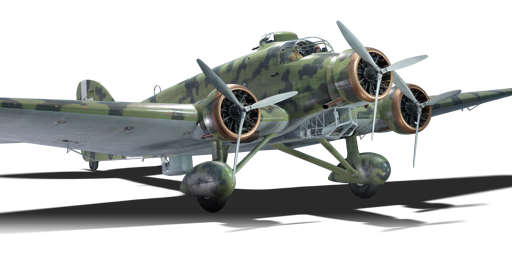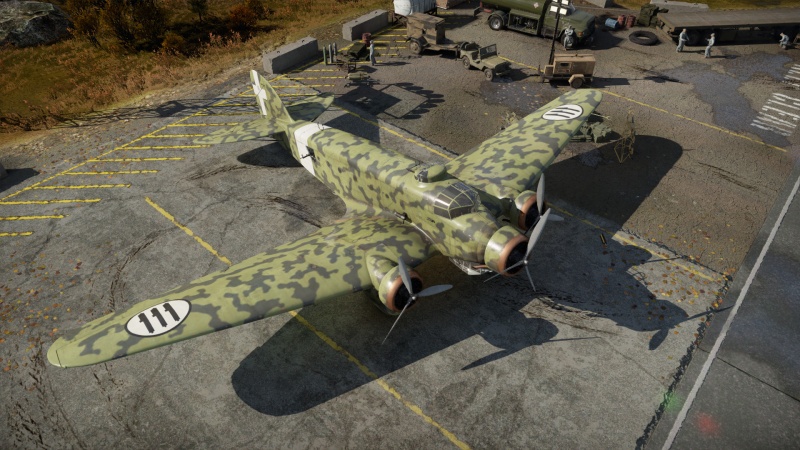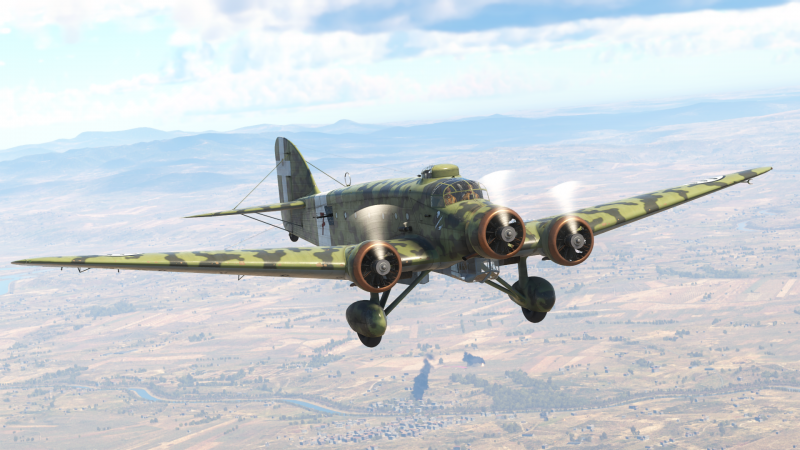S.81
Contents
Description
The S.81 was introduced in a time when Italy needed an aircraft capable of covering the large distances of the African Campaign, providing reconnaissance and the ability to carry bombs. Chief designer of the new project, Alessandro Marchetti developed the aircraft based on the Savoia's SM.73 airliner and militarized the vehicle for its intended use. The first prototype flew in 1935 and the aircraft was designated SM.81 Pipistrello ("Bat"). The aircraft served until 1944 with a total of 534 units built. For its time, the aircraft was considered one of the best medium bombers, but when World War II broke out it was already an outdated design. It served with Italian forces in Spain and Africa, and three were also sent to the Chinese Nationalist Forces but they were lost in training exercises in early 1938.
It was introduced in Update 1.71 "New E.R.A.". The S.81 is distinctive with its three engines, two on the wings and one in the nose. Each engine is less powerful than contemporaries on other aircraft so each engine loss will heavily impact the aircraft's speed, causing it to lose altitude, although the nose engine increases survivability. Three types of turrets are available on the S.81, a dorsal turret on top, a ventral turret on the bottom, and two beam turrets for both sides of the fuselage. All the turrets provide an excellent arc of fires on their sectors, with mutual machine gun fire from more than one turret able to be met in most areas, however these turrets only use 7.7 mm machine guns. The S.81 lacks any sort of armour and the crew is very likely to be injured in attacks, especially from below.
General info
Flight performance
| Characteristics | Max Speed (km/h at 4,000 m) |
Max altitude (metres) |
Turn time (seconds) |
Rate of climb (metres/second) |
Take-off run (metres) | |||
|---|---|---|---|---|---|---|---|---|
| AB | RB | AB | RB | AB | RB | |||
| Stock | 321 | 310 | 6800 | 30.1 | 31.3 | 3.9 | 3.9 | 450 |
| Upgraded | 351 | 335 | 28.0 | 29.0 | 9.4 | 6.3 | ||
Details
| Features | ||||
|---|---|---|---|---|
| Combat flaps | Take-off flaps | Landing flaps | Air brakes | Arrestor gear |
| ✓ | ✓ | ✓ | X | X |
| Limits | ||||||
|---|---|---|---|---|---|---|
| Wings (km/h) | Gear (km/h) | Flaps (km/h) | Max Static G | |||
| Combat | Take-off | Landing | + | - | ||
| 530 | 530 | 369 | 348 | 241 | ~4 | ~2 |
| Optimal velocities (km/h) | |||
|---|---|---|---|
| Ailerons | Rudder | Elevators | Radiator |
| < 260 | < 270 | < 270 | > 330 |
Survivability and armour
- No armour plating
- No armour glazing
- Critical components located at front of aircraft (fuel, pilot, engine, controls)
- More fuel tanks located in wings near fuselage
Modifications and economy
When grinding this plane for improvements and modules, focus on the payload first, then the plane performance. Ignore the defensive firepower upgrades as the defensive firepower upgraded is still extremely weak until its the last upgrades you have to get.
Armaments
Suspended armament
The S.81 can be outfitted with the following ordnance:
- 28 x 50 kg GP 50 bombs (1,400 kg total)
- 16 x 100 kg GP 100 bombs (1,600 kg total)
- 4 x 250 kg GP 250 bombs (1,000 kg total)
- 4 x 500 kg GP 500 bombs (2,000 kg total)
Defensive armament
The S.81 is defended by:
- 2 x 7.7 mm Breda-SAFAT machine guns, dorsal turret (500 rpg = 1,000 total)
- 2 x 7.7 mm Breda-SAFAT machine guns, ventral turret (500 rpg = 1,000 total)
- 1 x 7.7 mm Lewis machine gun, 2 x beam turrets (500 rpg)
Usage in battles
S.81 is a well armed beginner bomber for Italy, being able to carry a heavy load of bombs in different sizes. Though it doesn't possess the greatest speed, it's still a bomber for the enemy team to recognize as a threat for its carrying capacity of bombs. Being mixed up with bombers from other nations like He 111 H-3, F.222.2, or TB-3M-17-32, they can easily wipe out enemy bases and airfield.
S.81 is armed with 6 x 7.7 mm machine guns: 2 x Lewis (7.7 mm) and 4 x Breda-SAFAT (7.7 mm) which is pretty well armed for a low tier bomber. The two Lewis machine guns are placed at the middle rear of the plane in the sides, where they can cover if enemy planes are flying level next to the S.81. Meanwhile, the 4 x Breda machine guns are placed in two turrets that have 360° coverage above and below the bomber, being able to defend it from most angles. It is able to defend itself pretty well against biplanes from reserve ranks, but can have tougher opponents like I-16 type 24, Yak-2 KABB, P-36G, He 100 D-1, Potez 631, and J22-A that can make quick work of the S.81 as they are faster, more agile, and usually have more firepower than the S.81.
S.81 is able to carry 28 x 50 kg bombs, 16 x 100 kg bombs, 4 x 250 kg bombs or 4 x 500 kg bombs. Bombloads like 28 x 50 kg and 16 x 100 kg are excellent for carpet bombing convoys and knocking out light targets, meanwhile heavier bombloads like 4 x 250 kg and 4 x 500 kg are excellent for destroying bombing points and damaging airfields. They are all useful in ground battles.
Best use of S.81 in Air Battles is on clean up duty after other bombers that are way faster and might not have the bombload to take out bombing points in one go, or S.81 can go for stationary targets like pillboxes, light pillboxes, AA emplacements and artillery positions to bleed the enemy team's tickets.
In ground battles the S.81 can be good air support for allied ground units, protecting points that are being captured by hostile forces and with good communications with the ground teammates it can wipe out entrenched enemies that are likely to be protecting points or certain roads or areas of the map. But beware of enemy SPAA units, the S.81's slow speed makes it an easy target for most SPAA vehicles at its battle rating.
Manual Engine Control
| MEC elements | ||||||
|---|---|---|---|---|---|---|
| Mixer | Pitch | Radiator | Supercharger | Turbocharger | ||
| Oil | Water | Type | ||||
| Controllable | Not controllable Not auto controlled |
Not controllable Not auto controlled |
Not controllable Not auto controlled |
Separate | Not controllable 1 gear |
Not controllable |
Pros and cons
Pros:
- Great payload, can carry up to 2,000 kg of ordnance which can destroy 3 bases with ease
- Machine gun turrets can reach all sides of the bomber
- Potent, fast-firing defensive armament for its tier, with incendiary bullets that can easily set fabric-covered low-tier planes on fire.
Cons:
- Slow and sluggish
- No armour or bulletproof glass for protection
- Loss of a single engine will hamper the plane's ability to stay in the air
- Low maximum altitude
History
Under the need to have an aircraft capable reaching the far reaches of the Italian colonies in Africa, a project was made to develop an aircraft able to suit the Regia Aeronautica. Approaching manufacturer Savoia-Marchetti, chief designer Alessandro Marchetti developed the aircraft based on the Savoia's SM.73 airliner and militarized the vehicle for its intended use.[1] The first prototype was built and flown in early 1935, approximately six months after the SM.73 debuted.[2] This aircraft was then known as the SM.81 "Pipistrello" ("Bat"). The aircraft was accepted for service in the same year with mass-production slated, with different engines used throughout the production life. 534 SM.81 would be produced in the time span between 1935 to 1944.[3]
Combat usage
At its inception, the SM.81 was considered one of the better medium bombers of the era with its top speed of 211 miles, long range of 1,336 miles, well armed with six machine gun positions and able to carry a payload of up to 2,205 lbs.[3] The SM.81 found a versatile use on the battlefield, being used in a transport, bombing, ground attack, and a reconnaissance role, ensuring its relevancy even later in the war. One was procured by Benito Mussolini to be used as his private aircraft, the aircraft being nicknamed "Taratuga" ("Turtle") for its sluggish speed.
The SM.81 was first used in the Second Italo-Ethiopian War (also known as the Second Italo-Abyssinian War), lasting from 03 October 1935 to May 1936, quickly putting the SM.81 into action. Their versatile performed well in their support of the Italian troops, culminating with the annexation of Ethiopia into Italy's East African colonies. The SM.81 saw use again in the Spanish Civil War to aid the Spanish Nationalists in the Aviazione Legionaria, where they were used to the same degree as in Ethiopia. Though 12 were sent on a 705-mile flight on 29 July 1936 to Spanish-controlled Morocco, complexity in the flight had only nine arrive. These nine bombers provided a great asset in the Strait of Gibraltar as more aircraft arrived, keeping the Spanish Republican's Navy at bay. As the Nationalists push closer to Madrid, the SM.81, working alongside the German Condor Legion, bombed the Spanish capital almost daily. Though the SM.81 sometimes flew with escorting C.R.32 biplanes, flying unescorted with tight formations was also possible due to the mutual machine gun protection with each other.[4] However, when Soviet I-15 and I-16 appeared, flights started to be conducted at night to avoid losing precious bombers. When Italy left Spain at the conclusion of the war, around 64 SM.81 was left behind for the Spanish Air Force.
By the outbreak of World War II, the SM.81 was showing its age, though 300 units still remained in the Regia Aeronautica's inventory.[1] With the faster and more powerful SM.79 beginning to see service in 1936, the SM.81's roles was supplemented. The SM.81 still saw service in secondary roles and so deliveries still continued. It was used in the African theater as the main bomber against British forces in East Africa, but British Gladiators and Hurricanes posed a major threat. Due to this the SM.81 was relegated as a night bomber in North Africa, with the darkness as cover against the enemy fighters. 80 SM.81 were also produced into a dedicated transport aircraft, known as SM.81T, which proved vital in transporting troops and material to Rommel's Afrika Korps.[3]
Even after Italy's surrender to Allied forces in September 1943, the SM.81 still saw service in North Italy's Aeronautica Nazionale Repubblicana and South Italy's Aviazione Cobelligerante Italiana. Though South Italy soon removed them from service, North Italy used them until the end of the war.[1] In the conclusion of World War II, several SM.81 were still in service with the post-war Aeronautica Militare Italiana, sticking around until 1950 when they were all officially retired.
Other developments
Two main variants of the SM.81 existed, the SM.81 as a bomber/transport variant and the SM.81T as a dedicated transport aircraft, both using various engines as propulsion. A project was done known as the SM.81B, which used a two-engine configuration. This provided inadequate performance compared to the three-engine configurations and so the project was discontinued.
Though the SM.81 saw use in the various Italian air forces and in Spain, three were also sent to the Chinese Nationalist forces, arriving at an unknown date. However, all three samples were destroyed in training exercises in early 1938.[1]
Media
- Skins
- Videos
See also
- Aircraft of similar configuration and role
External links
References
- ↑ 1.0 1.1 1.2 1.3 Military Factory. "Savoia-Marchetti SM.81 Pipistrello (Bat) Medium Bomber / Transport Aircraft." Military Factory, 31 May 2017, Website.
- ↑ Century of Flight. "Savoia Marchetti S.M.81 Pipistrello." Italian Aircraft of World War Two, 11 Nov 2007, Web Archive.
- ↑ 3.0 3.1 3.2 Murphy, Justin D., and Matthew A. McNiece. Military Aircraft, 1919-1945: an Illustrated History of Their Impact. ABC-CLIO, 2009.
- ↑ Smith, Richard K., and R. Cargill. Hall. Five down, No Glory: Frank G. Tinker, Mercenary Ace in the Spanish Civil War. Naval Institute Press, 2011.
| Savoia-Marchetti | |
|---|---|
| Bombers | S.M.79 serie 1 · S.M.79 serie 8 · S.M.79 AS · S.M.79 bis/T.M |
| S.81 | |
| Attackers | SM.91 · SM.92 |
| Export | S.M.79 B |
| Captured | ▀S.M.79 serie 1 · ▀S.M.79 serie 4 · ▀S.M.79 serie 8 |
| ▀S.M.79 AS · ▀S.M.79 bis/N · ▀S.M.79 bis/T.M · ▀S.M.79 B | |
| Italy bombers | |
|---|---|
| Fiat | B.R.20DR · B.R.20M M1 |
| Savoia-Marchetti | S.81 · S.M.79 serie 1 · S.M.79 B · S.M.79 serie 8 · S.M.79 AS · S.M.79 bis/T.M |
| CANT | Z.1007 bis serie 3 · Z.1007 bis serie 5 |
| Piaggio | P.108B serie 1 · P.108B serie 2 |
| Foreign: | |
| Germany | ▄Ju 87 R-2 · ▄Ju 87 D-3 |
| Hungary | ◔Tu-2S-59 |






